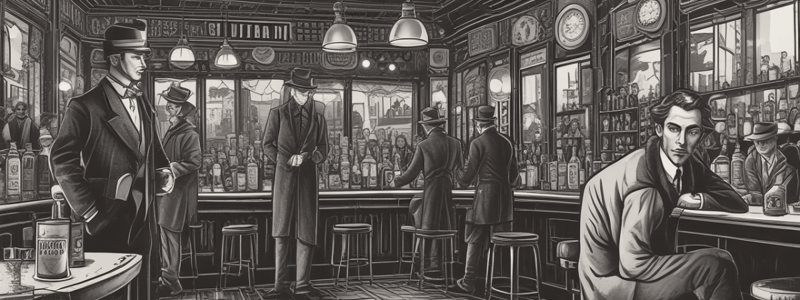Podcast
Questions and Answers
Where did the term 'speakeasy' originate?
Where did the term 'speakeasy' originate?
- United States
- England (correct)
- Ireland
- France
During Prohibition, the only legal establishments where the use of alcohol was permitted were pharmacies.
During Prohibition, the only legal establishments where the use of alcohol was permitted were pharmacies.
True (A)
Speakeasies used __________ or secret knocking patterns for patrons to gain access.
Speakeasies used __________ or secret knocking patterns for patrons to gain access.
passwords
What were some examples of codewords used when ordering alcoholic beverages during Prohibition?
What were some examples of codewords used when ordering alcoholic beverages during Prohibition?
Match the following terms related to the Prohibition era:
Match the following terms related to the Prohibition era:
What event led to the acceleration of the end of Prohibition in the United States?
What event led to the acceleration of the end of Prohibition in the United States?
What amendment repealed the 18th Amendment, ending Prohibition?
What amendment repealed the 18th Amendment, ending Prohibition?
Speakeasies were known for their open and visible locations during the Prohibition era.
Speakeasies were known for their open and visible locations during the Prohibition era.
Speakeasies often featured bartenders dressed in retro outfits, dim lighting, and a menu boasting ______-era cocktails.
Speakeasies often featured bartenders dressed in retro outfits, dim lighting, and a menu boasting ______-era cocktails.
Flashcards are hidden until you start studying
Study Notes
A History of Speakeasies in the USA
- Speakeasies were hidden bars that operated secretly during the Prohibition era in the United States (1920-1933).
- The 18th Amendment, written into law in January 1919, prohibited the manufacture, sale, and transportation of intoxicating liquors in the United States.
The Origins of Speakeasies
- The term "speakeasy" originated from 19th-century England and Ireland, where it referred to illegal watering holes.
- During Prohibition, the term gained widespread usage alongside a thriving clandestine drinking culture.
- The only legal establishments where alcohol was permitted were pharmacies and religious institutions.
Characteristics of Speakeasies
- Tucked away from the public eye, with no official entrance.
- Required passwords, secret knocking patterns, and codewords to gain access and order drinks.
- Examples of codewords used include "coffin varnish", "white mule", "horse liniment", and "monkey rum".
- Nicknamed "blind pigs" and "gin joints", with over 5,000 speakeasies in the country by 1922.
Inside a Speakeasy
- Upon gaining entry, patrons would be greeted by bartenders serving a wide variety of alcoholic beverages.
- Men and women mingled and partied together, defying traditional social norms.
- Speakeasies were one of the rare places where segregation was absent, with people from all cultures and races drinking together.
The Rise of Speakeasies and the Flappers
- Women could enjoy a cocktail in a speakeasy, away from the public eye.
- The rise of the Flappers, a generation of boisterous party girls, who ignored traditional Victorian values.
- Frequenting speakeasies and indulging in alcohol and jazz music, Flappers defined the party culture of the Roaring Twenties.
Connection to Bootleggers and Organized Crime
- Speakeasies were operated by mob bosses and organized crime syndicates that controlled the lucrative large-scale interstate liquor smuggling.
- Legendary gangster Al Capone reportedly made over $60 million a year supplying bootlegged alcohol to the thousands of speakeasies he owned.
The Decline of Speakeasies
- Prohibition proved to be an ill-conceived policy that sparked more controversies and problems for America.
- The 21st Amendment of 1933 repealed the 18th Amendment, allowing people to openly enjoy a drink in reopened saloons and bars.
- Speakeasies gradually went into decline, marking the end of the distinctive clandestine drinking culture.
Resurgence and Legacy of Speakeasies
- Today, many drinking establishments mimic the aesthetic and nostalgic appeal of speakeasies.
- These speakeasy-themed bars often feature dim lighting, retro outfits, and Prohibition-era cocktails.
- The legacy of speakeasies remains deeply connected to American society, with a growing nostalgia for the Roaring Twenties.
Studying That Suits You
Use AI to generate personalized quizzes and flashcards to suit your learning preferences.
